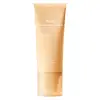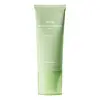What's inside
What's inside
 Key Ingredients
Key Ingredients

 Benefits
Benefits

 Concerns
Concerns

 Ingredients Side-by-side
Ingredients Side-by-side

Water
Skin ConditioningDibutyl Adipate
EmollientPropanediol
SolventCI 77891
Cosmetic ColorantBis-Ethylhexyloxyphenol Methoxyphenyl Triazine
Skin ConditioningDiethylamino Hydroxybenzoyl Hexyl Benzoate
UV FilterEthylhexyl Triazone
UV AbsorberPolysilicone-15
UV FilterNiacinamide
SmoothingCoco-Caprylate/Caprate
EmollientDiisopropyl Sebacate
EmollientPolymethylsilsesquioxane
Butylene Glycol
Humectant1,2-Hexanediol
Skin ConditioningGlycerin
HumectantMethylene Bis-Benzotriazolyl Tetramethylbutylphenol
UV FilterPentylene Glycol
Skin ConditioningIsododecane
EmollientOctyldodecanol
EmollientPotassium Cetyl Phosphate
EmulsifyingBehenyl Alcohol
EmollientPolyacrylate Crosspolymer-6
Emulsion StabilisingPolyglyceryl-3 Methylglucose Distearate
EmulsifyingPoly C10-30 Alkyl Acrylate
Emulsion StabilisingTromethamine
BufferingPolyglyceryl-4 Isostearate
EmulsifyingCI 77492
Cosmetic ColorantCarbomer
Emulsion StabilisingDecyl Glucoside
CleansingIsopropyl Titanium Triisostearate
EmollientAluminum Hydroxide
EmollientAcrylates/C10-30 Alkyl Acrylate Crosspolymer
Emulsion StabilisingMica
Cosmetic ColorantPolyester-1
Sodium Stearoyl Glutamate
CleansingEthylhexylglycerin
Skin ConditioningCI 77491
Cosmetic ColorantAdenosine
Skin ConditioningCI 77499
Cosmetic ColorantGlutathione
Silica Dimethyl Silylate
EmollientXanthan Gum
EmulsifyingTocopherol
AntioxidantAllantoin
Skin ConditioningMalus Domestica Fruit Cell Culture Extract
Skin ConditioningDipropylene Glycol
HumectantBeta-Glucan
Skin ConditioningHydrogenated Lecithin
EmulsifyingCholesterol
EmollientChitosan
Ascorbic Acid
Antioxidant3-O-Ethyl Ascorbic Acid
Skin ConditioningAscorbyl Glucoside
AntioxidantCeramide NP
Skin ConditioningWater, Dibutyl Adipate, Propanediol, CI 77891, Bis-Ethylhexyloxyphenol Methoxyphenyl Triazine, Diethylamino Hydroxybenzoyl Hexyl Benzoate, Ethylhexyl Triazone, Polysilicone-15, Niacinamide, Coco-Caprylate/Caprate, Diisopropyl Sebacate, Polymethylsilsesquioxane, Butylene Glycol, 1,2-Hexanediol, Glycerin, Methylene Bis-Benzotriazolyl Tetramethylbutylphenol, Pentylene Glycol, Isododecane, Octyldodecanol, Potassium Cetyl Phosphate, Behenyl Alcohol, Polyacrylate Crosspolymer-6, Polyglyceryl-3 Methylglucose Distearate, Poly C10-30 Alkyl Acrylate, Tromethamine, Polyglyceryl-4 Isostearate, CI 77492, Carbomer, Decyl Glucoside, Isopropyl Titanium Triisostearate, Aluminum Hydroxide, Acrylates/C10-30 Alkyl Acrylate Crosspolymer, Mica, Polyester-1, Sodium Stearoyl Glutamate, Ethylhexylglycerin, CI 77491, Adenosine, CI 77499, Glutathione, Silica Dimethyl Silylate, Xanthan Gum, Tocopherol, Allantoin, Malus Domestica Fruit Cell Culture Extract, Dipropylene Glycol, Beta-Glucan, Hydrogenated Lecithin, Cholesterol, Chitosan, Ascorbic Acid, 3-O-Ethyl Ascorbic Acid, Ascorbyl Glucoside, Ceramide NP
Water
Skin ConditioningZinc Oxide
Cosmetic ColorantButyloctyl Salicylate
Skin ConditioningPropylheptyl Caprylate
EmollientPropanediol
SolventC15-19 Alkane
SolventDisiloxane
Skin ConditioningIsododecane
EmollientCetyl Diglyceryl Tris(Trimethylsiloxy)Silylethyl Dimethicone
Emulsion StabilisingCaprylyl Methicone
Skin ConditioningIsopropyl Myristate
EmollientSodium Chloride
MaskingTriethylhexanoin
MaskingGlycerin
HumectantDisteardimonium Hectorite
StabilisingMethyl Methacrylate Crosspolymer
Polymethylsilsesquioxane
1,2-Hexanediol
Skin ConditioningTriethoxycaprylylsilane
Dipentaerythrityl Tri-Polyhydroxystearate
EmollientHouttuynia Cordata Extract
Skin ConditioningLauryl Dimethicone/Polyglycerin-3 Crosspolymer
CleansingPolyglyceryl-2 Dipolyhydroxystearate
Skin ConditioningPanthenol
Skin ConditioningCaprylyl Glycol
EmollientGlyceryl Caprylate
EmollientMelia Azadirachta Leaf Extract
Skin ConditioningMelia Azadirachta Flower Extract
Skin ConditioningButylene Glycol
HumectantCoccinia Indica Fruit Extract
Skin ConditioningAmber Powder
Dipropylene Glycol
HumectantSolanum Melongena Fruit Extract
Skin ConditioningCurcuma Longa Root Extract
MaskingOcimum Sanctum Leaf Extract
Skin ConditioningTocopherol
AntioxidantCorallina Officinalis Extract
Skin ConditioningMoringa Oleifera Seed Oil
EmollientSodium Citrate
BufferingLecithin
EmollientSodium Hyaluronate
HumectantAllantoin
Skin ConditioningDipotassium Glycyrrhizate
HumectantSodium PCA
HumectantArginine
MaskingCeramide NP
Skin ConditioningErythritol
HumectantAsiaticoside
AntioxidantMadecassic Acid
Skin ConditioningAsiatic Acid
Skin ConditioningCentella Asiatica Extract
CleansingPentylene Glycol
Skin ConditioningOctanediol
Water, Zinc Oxide, Butyloctyl Salicylate, Propylheptyl Caprylate, Propanediol, C15-19 Alkane, Disiloxane, Isododecane, Cetyl Diglyceryl Tris(Trimethylsiloxy)Silylethyl Dimethicone, Caprylyl Methicone, Isopropyl Myristate, Sodium Chloride, Triethylhexanoin, Glycerin, Disteardimonium Hectorite, Methyl Methacrylate Crosspolymer, Polymethylsilsesquioxane, 1,2-Hexanediol, Triethoxycaprylylsilane, Dipentaerythrityl Tri-Polyhydroxystearate, Houttuynia Cordata Extract, Lauryl Dimethicone/Polyglycerin-3 Crosspolymer, Polyglyceryl-2 Dipolyhydroxystearate, Panthenol, Caprylyl Glycol, Glyceryl Caprylate, Melia Azadirachta Leaf Extract, Melia Azadirachta Flower Extract, Butylene Glycol, Coccinia Indica Fruit Extract, Amber Powder, Dipropylene Glycol, Solanum Melongena Fruit Extract, Curcuma Longa Root Extract, Ocimum Sanctum Leaf Extract, Tocopherol, Corallina Officinalis Extract, Moringa Oleifera Seed Oil, Sodium Citrate, Lecithin, Sodium Hyaluronate, Allantoin, Dipotassium Glycyrrhizate, Sodium PCA, Arginine, Ceramide NP, Erythritol, Asiaticoside, Madecassic Acid, Asiatic Acid, Centella Asiatica Extract, Pentylene Glycol, Octanediol
 Reviews
Reviews

Ingredients Explained
These ingredients are found in both products.
Ingredients higher up in an ingredient list are typically present in a larger amount.
1,2-Hexanediol is a synthetic liquid and another multi-functional powerhouse.
It is a:
- Humectant, drawing moisture into the skin
- Emollient, helping to soften skin
- Solvent, dispersing and stabilizing formulas
- Preservative booster, enhancing the antimicrobial activity of other preservatives
Allantoin is a soothing ingredient known for its protective and moisturizingg properties. Because of this, it is often added to products with strong active ingredients.
Studies show higher concentrations of this ingredient can promote wound healing.
Though it can be derived from the comfrey plant, allantoin is produced synthetically for cosmetic products to ensure purity.
Learn more about AllantoinButylene Glycol (or BG) is used within cosmetic products for a few different reasons:
Overall, Butylene Glycol is a safe and well-rounded ingredient that works well with other ingredients.
Though this ingredient works well with most skin types, some people with sensitive skin may experience a reaction such as allergic rashes, closed comedones, or itchiness.
Learn more about Butylene GlycolCeramide NP is a type of ceramide and formally known as ceramide 3.
Ceramides are intercellular lipids naturally found in our skin that bonds dead skin cells together to create a barrier. They are known for their ability to hold water and thus are a great ingredient for dry skin.
Ceramides are an important building block for our skin barrier. A stronger barrier helps the skin look more firm and hydrated. By bolstering the skin ceramides act as a barrier against irritating ingredients. This can help with inflammation as well.
If you would like to eat ceramides, sweet potatoes contain a small amount.
Read more about other common types of ceramides here:
Ceramide AP
Ceramide EOP
Dipropylene Glycol is a synthetically created humectant, stabilizer, and solvent.
This ingredient helps:
Dipropylene glycol is technically an alcohol, but it belongs to the glycol family (often considered part of the ‘good’ alcohols). This means it is hydrating and gentle on skin unlike drying solvent alcohols like denatured alcohol.
As a masking agent, Dipropylene Glycol can be used to cover the smell of other ingredients. However, it does not have a scent.
Studies show Dipropylene Glycol is considered safe to use in skincare.
Learn more about Dipropylene GlycolGlycerin is already naturally found in your skin. It helps moisturize and protect your skin.
A study from 2016 found glycerin to be more effective as a humectant than AHAs and hyaluronic acid.
As a humectant, it helps the skin stay hydrated by pulling moisture to your skin. The low molecular weight of glycerin allows it to pull moisture into the deeper layers of your skin.
Hydrated skin improves your skin barrier; Your skin barrier helps protect against irritants and bacteria.
Glycerin has also been found to have antimicrobial and antiviral properties. Due to these properties, glycerin is often used in wound and burn treatments.
In cosmetics, glycerin is usually derived from plants such as soybean or palm. However, it can also be sourced from animals, such as tallow or animal fat.
This ingredient is organic, colorless, odorless, and non-toxic.
Glycerin is the name for this ingredient in American English. British English uses Glycerol/Glycerine.
Learn more about GlycerinIsododecane is a fragrance, emollient, and solvent.
As an emollient, it helps your skin stay soft and hydrated. Emollients help trap moisture into your skin.
Isododecane's role as a solvent makes it a great texture enhancer. It spreads smoothly on skin and does not leave a sticky feeling behind. Isododecane also helps prevent color transfer in makeup products.
Isododecane is not absorbed into skin.
Learn more about IsododecanePentylene glycol is typically used within a product to thicken it. It also adds a smooth, soft, and moisturizing feel to the product. It is naturally found in plants such as sugar beets.
The hydrophilic trait of Pentylene Glycol makes it a humectant. As a humectant, Pentylene Glycol helps draw moisture from the air to your skin. This can help keep your skin hydrated.
This property also makes Pentylene Glycol a great texture enhancer. It can also help thicken or stabilize a product.
Pentylene Glycol also acts as a mild preservative and helps to keep a product microbe-free.
Some people may experience mild eye and skin irritation from Pentylene Glycol. We always recommend speaking with a professional about using this ingredient in your routine.
Pentylene Glycol has a low molecular weight and is part of the 1,2-glycol family.
Learn more about Pentylene GlycolPolymethylsilsesquioxane is a silicone used as a film forming agent.
When applied to the skin, this ingredient creates an invisible film on the surface. This film still allows oxygen to pass through, but prevents moisture from escaping. This can help condition and hydrate the skin. It also leaves a silky feel when applied.
Polymethylsilsesquioxane has not been shown to clog pores. It has been deemed safe to use up to 55%, but most cosmetics use much less.
If you have concerns about using this ingredient, we recommend speaking with a professional.
Learn more about PolymethylsilsesquioxanePropanediol is an all-star ingredient. It softens, hydrates, and smooths the skin.
It’s often used to:
Propanediol is not likely to cause sensitivity and considered safe to use. It is derived from corn or petroleum with a clear color and no scent.
Learn more about PropanediolTocopherol (also known as Vitamin E) is a common antioxidant used to help protect the skin from free-radicals and strengthen the skin barrier. It's also fat soluble - this means our skin is great at absorbing it.
Vitamin E also helps keep your natural skin lipids healthy. Your lipid skin barrier naturally consists of lipids, ceramides, and fatty acids. Vitamin E offers extra protection for your skin’s lipid barrier, keeping your skin healthy and nourished.
Another benefit is a bit of UV protection. Vitamin E helps reduce the damage caused by UVB rays. (It should not replace your sunscreen). Combining it with Vitamin C can decrease sunburned cells and hyperpigmentation after UV exposure.
You might have noticed Vitamin E + C often paired together. This is because it is great at stabilizing Vitamin C. Using the two together helps increase the effectiveness of both ingredients.
There are often claims that Vitamin E can reduce/prevent scarring, but these claims haven't been confirmed by scientific research.
Learn more about TocopherolWater. It's the most common cosmetic ingredient of all. You'll usually see it at the top of ingredient lists, meaning that it makes up the largest part of the product.
So why is it so popular? Water most often acts as a solvent - this means that it helps dissolve other ingredients into the formulation.
You'll also recognize water as that liquid we all need to stay alive. If you see this, drink a glass of water. Stay hydrated!
Learn more about Water